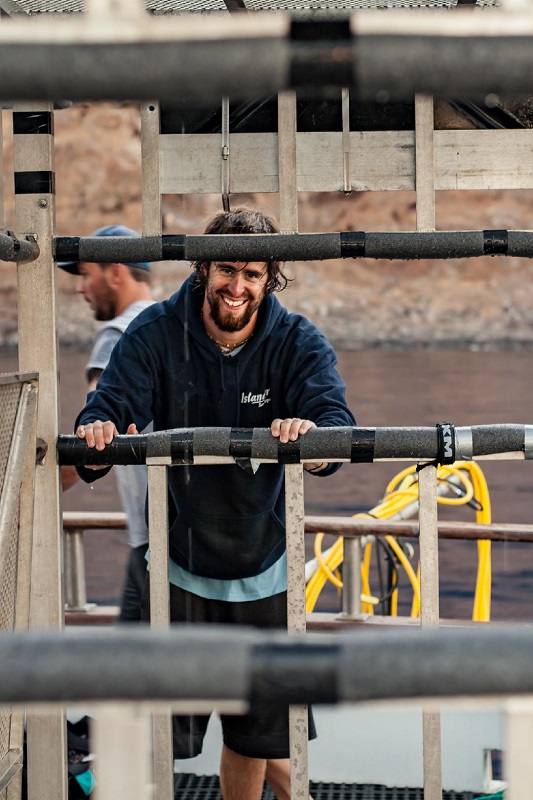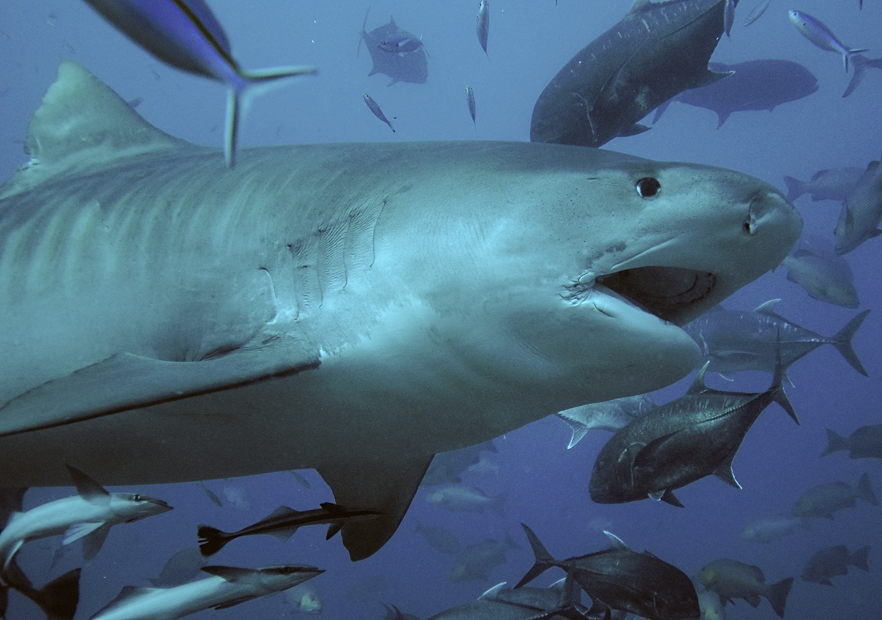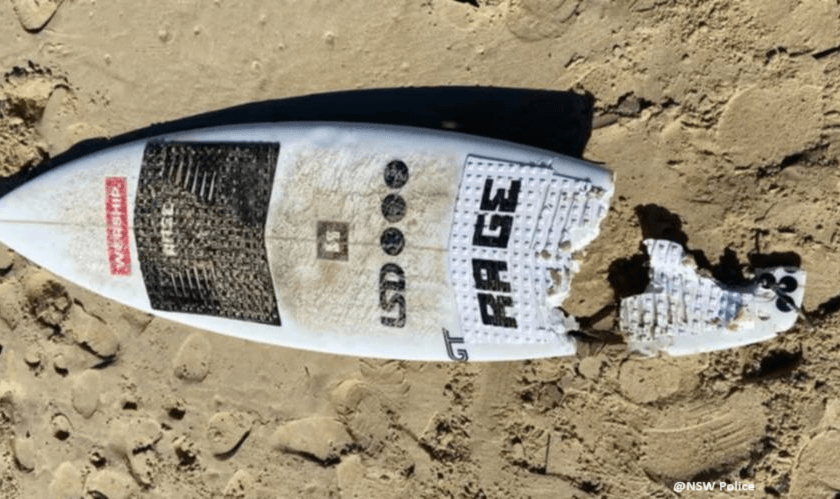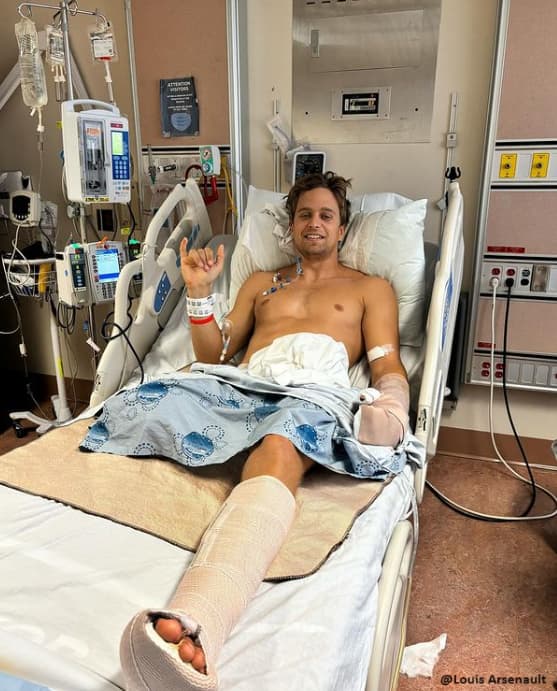Alex Wright has been sharing his experiences while working on a shark cage diving boat. In part two he told us about cage diving operations off South Australia.
Today, he’s taking us to Guadalupe Island
![]()
“After leaving South Australia in March of 2017, I had gotten home, and somehow lined up a job working as a PADI Divemaster for another cage diving operation based in San Diego, California. The was going to be a new experience for me, as I would be working and living on the board the boats as we worked off Guadalupe Island.
“The company that had hired me, Islander Charters Inc., is also a fishing, a kayaking, and a diving Charter Company. However, in the fall they operate as a shark cage diving boat from mid-September to mid-December.
“This job was my first job on a liveaboard since I was 24, and even then, that was the first time I was exposed to living on a boat. The boat I worked on was the M/V Islander, a 92-gross ton vessel. For the shark diving season, the boat holds 3 cages, 2 main cages for the clients and one deep cage for those that are certified scuba divers interested in going down deeper.
“I was hired as an assistant Divemaster, working with Jimi Partington who was the lead Divemaster of the company and who had been hired several years prior. Although my job was all-inclusive, I did everything from helping change the boat over from fishing season to cage diving in the beginning to selling shirts at the end of the trip towards the end of the season.
“I had many jobs working for this outfit, when in San Diego I rode down to Ensenada, Mexico with the clients to board the boat. I was responsible for getting them across the border and giving out drinks and snacks along the way.
“When the bus arrived at the dock, I helped unload the luggage and helped stow them away and helped guests to find their staterooms. After the boat was cleared from customs, we departed.
“The captain and Jimi would give their safety briefings shortly after departing and myself and one or two other crew -members would organize the dive gear. We would hang the wetsuits up with the matching number given to the client during the cage briefing. We would then assign a crate to the client with the number and name on it, and it would be up to the client to keep track of anything in that crate for the remaining duration of the trip.
“After the dive gear was organized, the first day of travel was a relaxed day. Jimi and I would do dishes and serve dinner that night, and during each trip all the crew were given watches to drive the boat at night and keep an eye out for traffic and to stay on course.
![]()
“The next day, Fernando, a deckhand, and I would assemble the cages, hook up the regulators to the valves to deliver air to the clients, and attach the safety door to the cage (which we removed every night, so people could walk through to the back deck). Then, with the help of Jimi and another deckhand we would lift the cages with a boom operated by both the captain and second captain, and push it out and over the railing, setting the cage in the water.
“Then we would pull the cage in behind the boat using rope and attach it to the bottom step of the back deck. I would normally tie off the bottom of the cage with a line to the boat cleat.
“After hooking the arms up, we would do the same thing with the other cage and then either myself, or Jimi would attach the cages to each other with bungee cords, open the topside hatch, jump in and close the bottom to make it complete. We would open that at the end, so it is easier for the water to escape, and it becomes lighter to lift when it’s open.

“A safety net was then placed under the arms and to the step and the cages. The cages here are a lot different than both the other locations. While the cages are still made out of steel, they have larger viewing gaps and the space between the bars is fairly spacious as well.
“These cages were not composed of round steel bars and had no inner bars for your hands or feet. Jimi would then do another briefing on how to enter and exit the cage.
“Before the first trip, bait was brought on for the first 3 trips. Bait, being tuna heads, from their fishing season. We had a break in between the 3rd trip and 5th trip so more bait was brought down, at least enough for a few more trips. Unfortunately, our boat did not have enough space for all the bait required for the season and it is better to have fresh bait anyway. The bags of bait were stored in a refrigerated room on the bow.
![]()
“After the cage is in, and people are in, I usually start baiting, and so does one other deckhand. It becomes a waiting game, like the other spots.
“Meanwhile, in the galley breakfast has been served before the first group gets in the cage and is now onto mid-morning snack. Rotations happen every hour, until 5 p.m. or 6 p.m. Lunch and afternoon snack happens during the rotations so that everyone gets a chance to eat.
“My job as an assistant Divemaster was ten-fold. During the trip, I was responsible for keeping the back deck clean, and pulling bait before arriving at Guadalupe the following morning. The cages would be placed in the water each morning and removed each night.
![]()
“Clients would have a total of 2.5 days of diving. The morning that we arrived, the day after, and then the final day would be cut in half to get back to port early the next morning. During the 2 days of diving, we would be anchored up at Guadalupe, living there.
“The crew and I were also responsible for cleaning the heads, the galley, and the boat itself during the trip. There was no fishing allowed at Guadalupe, and we were only allowed to use tuna heads that we either got ourselves during the fishing season or that was purchased locally in Ensenada, Mexico.
“During the first several trips, we were required to have an observer from the government, CONANP, to make sure we were following the guidelines, and the sharks and clients had a safe interaction. Needless to say, we did not need an observer halfway through the season due to our good safety record of arranging that interaction.
“I would have to say that the main difference between this job and my past jobs on shark cage diving boats was the liveaboard aspect, I had not lived on a boat as much as this job. That, and the observer on board whereas the other jobs had other ways of being regulated. For instance, in South Australia if we had an observer on board from the government we would not know who they were, only that they were there.
![]()
“During the 3-month season I was working on the boat, I saw numerous Great Whites. Each one had a different personality, and yet each one was curious about what we were doing in the cages.
“We did not see many juvenile Great Whites at Guadalupe, and it is thought to be a mating ground for the sharks as well as a great source of food, particularly the presence of California elephant seals.
‘The biggest shark I saw arrived at Guadalupe during my last trip of the season. The 18- foot unknown female, had a large girth, a calming presence and was very curious about us in the water. She just circled us, eyeing us in the cage and occasionally going after and missing the bait. Sometimes she would catch me off guard and grab the bait, it was always a bit of fun when the sharks grabbed the bait because it was a little play between them and I.
“Sometimes we would see juvenile sharks in the beginning of the season, and during the middle of the season we saw a small Mako, and dolphins, with the occasional ray and sea turtle sighting. One trip we arrived and noticed beaked whales in the area. The 18-foot female certainly was the biggest shark I had ever seen in my life. Words cannot describe how I felt in the presence of this amazing animal”.
This concludes Part Three of What it’s like working on a shark cage diving boat. Be sure to check back for Part four when Alex gives his final thoughts on this adventure.
All photos courtesy of Alex Wright
![]()
Christian Kemper is a TV journalist from Germany. He has been diving with and studying sharks for more than 20 years. He has written two books about shark attacks and one book about crocodiles. He is a freelance writer for 3 of the biggest diving magazines in Germany.
You can find his German Language book Strange Pool Friends on Amazon and at tredition.
He has also written a three part article about how cage diving with great white sharks began.


